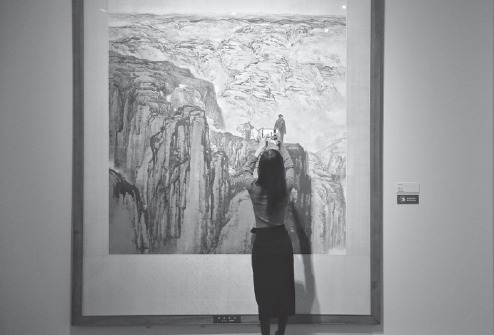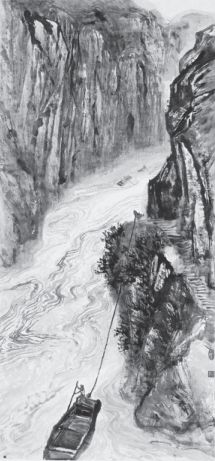Strokes of genius
A new exhibition focuses on Shi Lu, an artist who changed the face of traditional Chinese painting, Lin Qi reports.

Hailing from a well-to-do family in Southwest China's Sichuan province, artist Shi Lu (1919-82) is widely recognized as a co-founder of the influential Chang'an school of painting, a painters' group that has prevailed in Northwest China since the early 20th century, with Shaanxi province as its creative center.
Shi Lu, who was named Feng Yaheng at birth, moved to Yan'an, the cradle of the Chinese communist revolution, in the 1930s and lived in Shaanxi for several decades. He is noted for imbuing the techniques of classic Chinese ink-water painting with a realistic approach-providing the modern context in which the centuries-old painting style could thrive. His work reflects China's revolution and the livelihoods of common folk, through the depictions of the natural scenery of Northwest China and especially of northern Shaanxi province. It departs from the self-admiring mood commonly found in classic Chinese painting.
"We love the extensive Northwest (of China)," he once said of the group.
"We've grown a passion for the imposing landscapes in the area, the magnificence of the inhabitants and the greatness of the revolutionary course and socialist construction.
"Strength, majesty and straightforwardness are the main features of our approach to art," he said.
Shi Lu said it was a long path to pursue his artistic passion.
"I have very little time to carve a niche, and I feel rather regretful," he said.
Although he experienced a mental breakdown in the 1970s, he left an oeuvre comprising landscapes, portraits, flower-and-bird paintings, calligraphic scrolls, seal cuttings and poems, as well as articles on art theory.
Late artist Wu Guanzhong once described Shi Lu as "a guardian, in hardship and suffering, of the world of art".
An Evergreen Path of Art, an exhibition now on at the National Museum of China, commemorates Shi Lu's centennial by showing about 400 paintings, drawings, sketches and other works from his legacy, as well as objects-such as the stone slab and paintbrushes-he used to produce art.
The exhibition, which runs through Feb 9, 2020, includes a selection of work curated from three donations by the artist's family to the National Museum in 2012, 2014 and 2017.
Among them are dozens of drafts Shi Lu produced for his most iconic work, Fight in Northern Shaanxi. The colored painting on paper, which is more than 2 meters in height and width, is also on display alongside the sketches.
The painting shows Chairman Mao Zedong from behind, standing on a cliff surrounded by expansive mountain ranges. Shi Lu adopted the unique approach to not depict the leader facing the viewer but, rather, showing his back to indicate Mao's confidence in the final triumph in the civil war (1945-49).
Fight in Northern Shaanxi was moved to the exhibition from a permanent display at the National Museum's central exhibition hall on the ground floor, where it normally stands among the "red classic" paintings that reflect China's revolutionary course.
Shi Lu completed Fight in Northern Shaanxi in 1959. It shows his fusion of the style of classic Chinese landscape paintings with a modern sense of aesthetics.
Before he worked on the piece, Shi Lu took two trips to India and Egypt to exchange ideas with local artists, sightsee and sketch.
Zheng Yan, the exhibition curator, says these journeys enhanced the artist's firm belief in "carrying on the Chinese painting traditions through which he anticipated a promising future for Chinese art on the world stage".
Zheng says Shi Lu spent a lot of time reading classic books on Chinese aesthetics, and copying paintings and calligraphic pieces by ancient masters. In doing so, he sought to establish his own style and a new orientation for Chinese painting.
Fight in Northern Shaanxi, along with other pieces from Shi Lu's body of work, exemplifies his efforts to create work that "reaches out one hand to tradition and the other to real life".
His paintings unveil the natural panoramas of Northwest China, exuding the same stately energy one can find in the landscape works by great ancient painters of China.
At the same time, he zooms in on the farmers, soldiers, vendors and other figures among the common people, who were seldom portrayed in the classic paintings, to create an emotional attachment with his audience.
His works deliver an idealistic and poetic vision, while embodying a realistic spirit that defines the essential value of the Chang'an school of painting.
"Northern Shaanxi is so distinctive that it looks like an extensive land that has just been swept by a flood," Shi Lu once said. "For those who have seen a lot of fertile greenery, the scenery may seem too dry, but it boasts a sense of beauty of its own-in this way, nature inspires us."




Today's Top News
- Another sign of Japan's right-wingers' dangerous ambition to break free of all postwar constraints
- Hainan's special customs operations start strong
- Macao SAR holds flag-raising, reception to mark 26th anniversary of return to motherland
- China issues rules to regulate pricing practices of internet platforms
- US hits over 70 IS-linked targets in Syria in massive retaliatory strikes
- Coffee needs cooperation, not confrontation






























